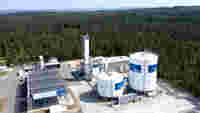A Secure Path to the Cloud

Linde has developed an air separation system that allows extremely flexible operation according to the situation on the electricity market. In order to prevent this innovative operating method from causing increased loads or efficiency losses in the system, Linde has set up a sophisticated, cloud-based monitoring system. With its Cloud Connectivity solution, WAGO ensures that the measurement data is reliably transmitted to the cloud.
The air separation plants designed by Linde work almost like Rumpelstiltskin spinning straw into gold: The systems produce valuable chemical elements from air, such as oxygen for the healthcare industry, nitrogen for food manufacturers and argon for the electrical industry. However, there is nothing magical about the system. Instead, the gymnasium-sized systems with their characteristic towers are the result of incredible features of engineering. The method for gas separation that underlies these systems was developed by the company’s founder, Carl von Linde, in the 19th century, and is therefore called the “Linde process” in his honor.
Your Benefits:
Highly flexible operation of air separation plants with WAGO
Data collection and transmission to the cloud with Cloud Connectivity
PFC200 Controller IoT Gateway – Increased Availability, Better Performance




